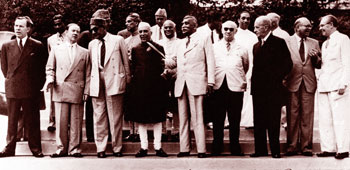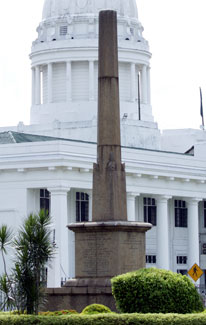The origin of the Colombo Plan dates back to the Commonwealth Foreign Ministers’ Conference held in Colombo on January 9, 1950. Sri Lanka’s (then Ceylon’s) ministerial delegation to the conference comprised Prime Minister D.S. Senanayake, Finance Minister J.R. Jayewardene, Justice Minister Sir Lalitha Rajapakse and Parlimentary Secretary to the Minister of External Affairs, R.G. Senanayake.
10-year plan
At this conference, Minister Jayewardene proposed that a committee be set up to prepare a 10-year plan for the development of countries in Southeast Asia through international collaboration. His proposal, incidentally had the same features as that put forward by the Australian delegation led by Sir Percy Spencer.
 |
| 1950: The Founding Fathers of the Colombo Plan |
Thus, credit for the formulation of the Colombo Plan concept should go to both then Minister Jayewardene and Sir Spencer, the then Australian Foreign Minister. The draft resolution tabled by Minister Jayewardene read: “To ensure a high and stable level of employment and to raise the standard of living of under-developed countries in Southeast Asia, whether within the Commonwealth or outside it, it is necessary to develop their agricultural and industrial economies.
“This conference, therefore, agrees to appoint a committee of officials of the countries concerned to obtain information and to prepare a 10-year plan for the development of these countries. The other members of the Commonwealth should consider means of providing such assistance as may be necessary for the implementation of this plan with money, guaranteed prices, technical skill and machinery.
“The Plan should be examined by a committee of experts who after visiting the countries concerned shall make recommendations with regard to the help which the Commonwealth countries can give in carrying out this programme.”
It is apparent that Minister Jayewardene’s proposal had been motivated by a desire to improve the lot of the peoples of the Southeast Asian countries as the living standards at the time were very low. The average income per head, when we were granted Independence in 1948, was about Rs. 20 and life expectancy around 50 years.
Elimination of poverty
The conference, after discussing the resolution tabled by Sri Lanka and Australia, agreed to recommend to the respective governments how to promote economic development in Southeast Asia.
The resolution in effect gave vent to the situation prevailing in these countries at the time and the desire to eliminate poverty and improve living standards through international co-operation and collaboration. It was adopted at the conference thereby preparing the stage for the launching of the Colombo Plan.
The leaders who attended the Foreign Ministers’ Conference in Colombo and conceived the Colombo Plan concept could, therefore, be rightly called its founding fathers. They were: D.S. Senanayake, J.R. Jayewardene, Sir Lalitha Rajapakse and R.G. Senanayake (Sri Lanka); Sir Percy Spencer (Australia); Jawaharlal Nehru (India); Frederick Diodge (New Zealand); Lester Pearson and R.W. Mayhew (Canada); Earnest Bevin and Phillip Noel Baker (Great Britain); and Paul Sauer (South Africa).
Following the resolution adopted at the Colombo Conference, the first meeting of the Consultative Committee was held in Sydney on May 10, 1950, convened by the Australian government.
The preparation of a National Development Plan by each country determining the priorities and stating the amount of assistance needed, the setting up of a Commonwealth Technical Assistance Scheme to provide assistance staggered over three years from July 1, 1950, with Great Britain, Australia, New Zealand and Canada contributing 80% of that amount and the establishment of a Bureau in Colombo to implement the Technical Assistance Programme, were some of the important decisions taken at the Sydney meeting, the recommendations of which were to be put forward to the respective governments for approval.
Task of co-ordinating
The task of co-ordinating the preparation of the development plan, while seeking the co-operation of non-Commonwealth countries in Asia was entrusted to the Australian government which work was completed by the time the London conference was held on September 25, 1950.
Two reports prepared by officials in advance, one on economic development in South and Southeast Asia and the other on the technical assistance scheme were discussed at the London conference. On agreement being reached, the report 'The Colombo Plan for Co-operative Economic Development in South and Southeast Asia', was adopted unanimously, which once again, was to be considered by the individual governments in the Commonwealth.
Establishment of C Plan
With all governments agreeing, the Colombo Plan was launched on July 1, 1951 as a regional inter-governmental organization aimed at Cooperative Economic Development in the countries of South and Southeast Asia.
 |
| The monument opposite the Town Hall to commemorate the
inauguartion of the Colombo Plan. |
The Colombo Plan embodies the concept of collective international effort towards the economic and social development of member countries in the Asia Pacific region.
It provides a forum for discussion of the development needs of member countries and for the exchange of information and acts as a catalyst for information on new ideas or existing concepts which need further encouragement and support. It is significant that all decisions are by consensus among member countries.
In fact, the principles underlying the operation of the Colombo Plan are amply demonstrated by its motto ‘Planning Prosperity Together’.
It is to the credit of this body that it has pioneered the networking of international and regional organizations with a view to ensuring that their combined resources are put to effective use in the region and are shared to meet the needs of member countries.
Technical co-operation among developing member countries, a feature once again pioneered by the Colombo Plan, has been substantial and resulted in the transfer of expertise in different fields and discipline. Developed member countries have also contributed their share in a larger measure where technical assistance is concerned.
The Population Programme, the Drug Advisory Programme and the Technical Development Projects initiated under the auspices of the Colombo Plan in the past, have helped developing countries in South and Southeast Asia in their development efforts, especially in the fields of agriculture, industrial research, power, irrigation, rural development, water management, health, education, science and technology.
Decrease in assistance
However, the assistance flowing through the Colombo Plan has been on the decrease as a result of bilateralism of international aid and the surfacing of specialized international agencies. That situation led to the re-orientation of the activities of the Colombo Plan. As at present the Colombo Plan concentrates only on permanent and regular training programmes that are relevant to developing member countries and programmes formulated on a project-by-project basis that meets the development needs of the member countries in the areas of social and economic development. Currently they include the Programme for Public Administration to train public servants in Public Administration to meet the changing needs of a market-oriented economy, the programme for Private Sector Development focusing on small and medium enterprises and entrepreneurship development and the Drug Advisory Programme aimed at eliminating drug abuse covering both demand and supply reduction.
The South-South Technical Cooperation/Data Bank collects and disseminates information on the activities of the public and private sectors of member countries. The Staff College for Technical Education based in Manilla, Philippines, functions as a specialized agency of the Colombo Plan where training needs are met.
The Consultative Committee
The Consultative Committee which consists of all member countries is the policy making body and meets every two years. While reviewing the activities of the Colombo Plan it decides on development issues in the region and technical co-operation programmes.
Council
The Colombo Plan Council which also consists of all member countries meets in Colombo several times a year. The heads of the diplomatic missions in Colombo represent their countries at the council meetings.
The council identifies the necessary development issues and recommends measures to be taken to the Consultative Committee and follows up implementation of the Consultative Committee decisions and directives.
What is admirable is that the Colombo Plan has the flexibility to meet the changing needs of the countries in the region, with due respect for the views of the member countries, while arriving at decisions by consensus. The present Chairperson of the Colombo Plan Council is Kathy Klugman, High Commissioner of Australia to Sri Lanka and Maldives.
The Colombo Plan Secretariat, headed by the Secretary General, provides the administrative support for the implementation of the programmes decided by the Consultative Committee and assists the Colombo Plan Council in discharging its functions. The Secretary General is in charge of all administrative and financial matters on which he has to report to the Council. Ms. Patricia Yoon – Moi Chia is the present Secretary General.
Present members
The Colombo Plan now has a membership of 26 countries, as aid-givers and aid- receivers, and is no more a Commonwealth organization. Two of the original nations, Canada and Great Britain, withdrew from the Colombo Plan in 1991, while South Africa earlier lost membership on leaving the Commonwealth. The present members of the Colombo Plan are Afghanistan, Australia, Bangladesh, Bhutan, Brunei Darussalam, Fiji, India, Indonesia, Iran, Japan, Republic of Korea, Laos, Malaysia, Maldives, Mongolia, Myanmar, Nepal, New Zealand, Pakistan, Papua New Guinea, Philippines, Singapore, Sri Lanka, Thailand, United States of America and Vietnam.
The Colombo Plan was originally intended to be a temporary programme to meet the post-war development needs of the countries in the region. Nevertheless, its longevity is proof of the success of one of the oldest inter-governmental organizations.
The Colombo Plan, no doubt, has made a significant contribution towards the economic and social development of the Asia Pacific region and has a role to play in the future too enhancing the prosperity of the peoples of the region
The writer is Vice Patron, Colombo Plan International Society |



